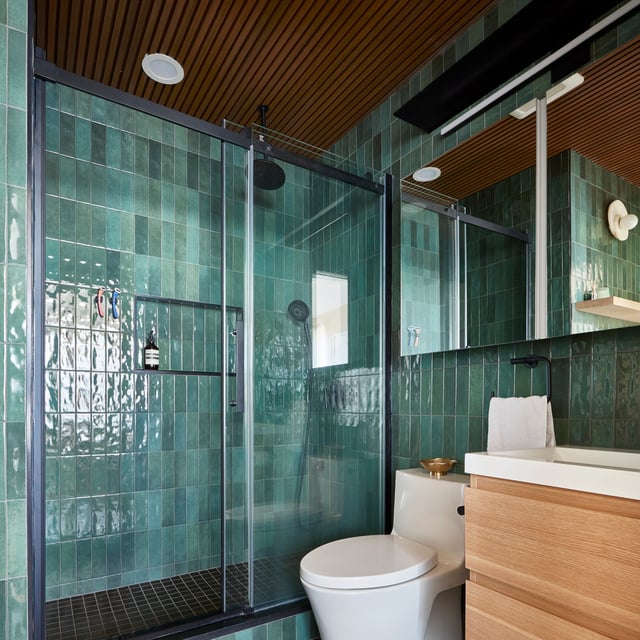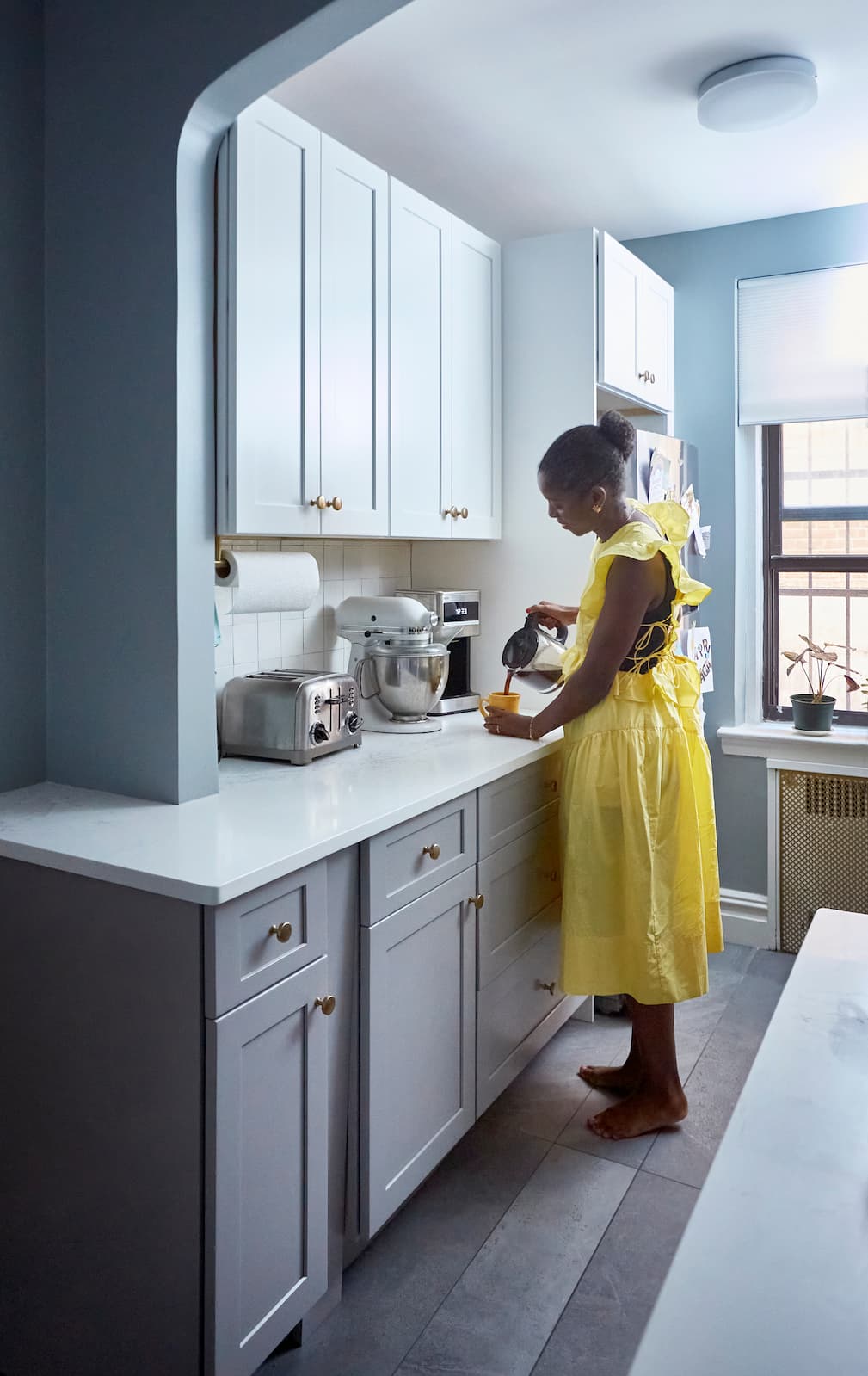
ceiling
Cathedral Ceiling Ideas - Trim, Molding, Beams & Lighting
12.16.2025
Our New Year savings event is here: Get up to $6,500 off your project today (terms apply).


In This Article
Ceilings are often treated as an afterthought, even though they take up just as much visual space as any wall. But when designed with intention, a ceiling can do more than blend in—it can define a room. From subtle textures to bold architectural choices, ceiling updates can shift how a space feels, adding dimension, character, and a touch of the unexpected. Whether you’re tackling a full renovation or considering a simpler cosmetic update, here are a few ways to rethink the fifth wall.
A ceiling doesn’t need a full redesign to make an impact. Sometimes, a single, well-chosen color is enough to shift the feel of a space. In bedrooms or nurseries, soft blue ceilings can create a calming, open atmosphere—almost like a breath of fresh air. In kitchens, playrooms, or studios, a bold orange overhead adds instant energy and warmth, giving the space a more playful, dynamic edge. And in dining rooms, deep tones like navy or forest green can add intimacy and visual weight, setting the stage for slower, more memorable meals.
This approach works best in rooms with neutral walls, where the ceiling becomes the visual centerpiece—quietly bold, but never overpowering.
Extending the ceiling color a foot or two down onto the upper walls creates a cocooning effect, making the room feel taller and more cohesive. This technique is ideal for bedrooms, where you want a sense of enclosure and comfort, or in a cozy reading nook to create a defined, intimate zone. In open-plan living spaces, this approach can help visually separate one area from another without using physical dividers. It’s also a smart design idea for rooms with unusual ceiling angles or slopes, as it blurs the transition between wall and ceiling.
Wallpapering your ceiling is a design idea to showcase your personality—especially in small bathrooms or compact spaces. By keeping the walls light and minimalist, you maintain an open, airy feel while still creating a memorable design moment overhead.
In a bathroom with a soaking tub, a patterned ceiling gives you something beautiful to look at while you relax. In a bedroom, a subtle grasscloth or a dreamy cloud print can add texture and interest above the bed. This idea is also perfect for entryways or hallways, where a patterned ceiling can create a memorable first impression without overwhelming the space.
Tin ceilings are a classic and surprisingly versatile choice. Their intricate patterns add vintage charm, but they can also be painted to match the walls for a more contemporary look. Tin panels work well in kitchens, dining rooms, or entryways, and their reflective surface can help bounce light around the room. Tin ceilings are especially fitting in late 19th- and early 20th-century homes—such as Colonial Revival, Edwardian, or early Craftsman styles—where they can restore period character. For a cohesive effect, consider painting the tin the same color as your walls, or go bold with a contrasting hue to make the ceiling a true focal point.
Natural wood planks add warmth and organic texture, making them an ideal design idea for bedrooms, living rooms, or vaulted spaces where you want to highlight the ceiling’s architecture. In a remodeled cabin or rustic home, wood planks reinforce the cozy, natural vibe. In a modern home, lighter woods can create a Scandinavian-inspired retreat. Wood planks are also a smart choice for home offices, where they help absorb sound and create a calming atmosphere. They’re particularly well-suited for ranch home remodels, where their linear pattern complements the long, low lines of the architecture and brings a sense of continuity and flow throughout open floor plans.
Painted wood planks offer the texture of wood with a lighter, more modern feel. In a coastal-inspired living room or sunroom, white or pale blue planks evoke breezy, beachy charm. In a child’s bedroom, painted planks in soft pastels add whimsy and color. This approach is also effective in basements or low-ceilinged rooms, where lighter colors help open up the space.
Exposed wood beams stained in a natural finish add rustic character and architectural drama. They’re a natural fit for vaulted ceiling design ideas, but can also be used in standard-height rooms to create a sense of history and craftsmanship. The natural stain highlights the wood’s grain and imperfections, making each beam unique. Pair with neutral walls and simple furnishings to let the beams take center stage.
Painting wood beams the same color as the ceiling creates a subtle, tone-on-tone effect that adds depth without overwhelming the room. This is a smart choice for modern or minimalist spaces, or for rooms where you want architectural detail without strong contrast—such as a serene bedroom or a contemporary living room. Painted beams can also help unify spaces with varying ceiling heights or unusual angles.
Design a Home That’s Uniquely Yours
Block can help you achieve your renovation goals and bring your dream remodel to life with price assurance and expert support.
Get Started
A thoughtfully designed ceiling can elevate your entire home, adding character, comfort, and a sense of completion. Whether you’re dreaming of a bold pop of color, the warmth of natural wood, or a creative solution for a small basement ceiling, Block Renovation is here to help. Our team connects you with experienced professionals and guides you through every step of your renovation, ensuring your ceiling—and every other detail—reflects your personal style and the way you want to live.

Written by Block Renovation

Renovate confidently with Block
Easily compare quotes from top quality contractors, and get peace of mind with warranty & price protections.
Thousands of homeowners have renovated with Block

4.5 Stars (100+)

4.7 Stars (100+)

4.5 Stars (75+)

ceiling
Cathedral Ceiling Ideas - Trim, Molding, Beams & Lighting
12.16.2025

ceiling
Decorative Ceiling Beam Ideas for Character, Warmth, and Style
12.16.2025

ceiling
Coffered Ceiling Ideas: Paint Colors, Lighting & More
12.16.2025

ceiling
Modern Tray Ceiling Ideas for Master Bedrooms
12.15.2025

Bathroom
Slanted Roof Bathrooms and Shower Design Ideas
11.22.2025
Renovate confidently